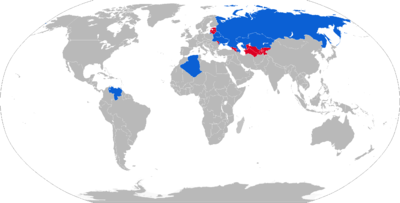2S12 Sani
| 2S12 "Sani" | |
|---|---|
|
2S12 Sani | |
| Type | Heavy mortar |
| Place of origin | Soviet Union / Russia |
| Service history | |
| In service | 1981 – present |
| Wars | Soviet war in Afghanistan, First and Second Chechen Wars |
| Production history | |
| Designed | 1981 |
| Manufacturer |
Uraltransmash Works (Ekaterinburg, Russia) Motovilikha Plants Corporation (Perm, Russia) |
| Number built | 1500+ pieces |
| Specifications | |
| Weight | 190.5 kg (420 lb) without transport chassis |
| Crew | 4 gunners, 1 commander (plus 2 prime mover crew) |
|
| |
| Shell | 120 mm HE mortar bombs |
| Carriage | 2F510 2x1 wheeled transport chassis, GAZ-66 4×4 truck (prime mover) |
| Elevation | 45°–80° |
| Traverse | ±5° from center |
| Rate of fire | 12 rds per minute[1] |
| Effective firing range |
Minimum: 0.5 km (0.31 mi) Maximum: 7.1 km (4.4 mi) |
| Sights | MPM-44M graduated sight |
The 2S12 "Sani" (GRAU index) is a 120 mm heavy mortar system used by the Russian Army and other former Soviet states.[2] First fielded in 1981, the 2S12 is a continued development on the towed mortars first used in World War II.
Design

2S12 is in fact the designator for the combination of the 2B11 "Sani" heavy mortar with its transport vehicle 2F510, a GAZ-66-15 4x4 truck. The 2B11 weighs nearly 500 lb when fully assembled, and thus must be mounted to the 2x1 wheeled chassis 2L81 and towed to the emplacement site by the truck. The GAZ-66 prime mover also transports the ammo load: 24 70-lb crates of 120mm HE mortar bombs, 2 bombs per crate, for a total of 48 available rounds.[3]
Once on site, it is unloaded from the transport chassis and manually emplaced by the crew of 5. It is the largest caliber indirect artillery employed at the battalion level.
There is also an improved model, the 2B11M, that can fire the laser-guided round "Gran" with a range of 7,500 m. 2S12A and 2S12B improved models are in service now.[4] 2S12A got a new "Ural" family transport vehicle with high power diesel engine and electric hoist for loading the mortar and a new base plate with a hinge that allows for pointing horizontally without turning the heavy support.[5]
Variants
Some countries have developed self-propelled versions of the 2B11:
- SMM 74 B1.10 "Tundzha-Sani" – Bulgarian version on MT-LB.
- SM120 – Belarusian version on MT-LBu.
- Aybat – Kazakh version on MT-LB.
Operators

Current operators
Former operators
See also
- List of heavy mortars
- M120 120 mm mortar 120 mm mortar
- 2B11 Sani 120 mm mortar
- Cardom 120 mm recoil mortar system
- Soltam K6 120 mm mortar
- Soltam M-65 120 mm mortar
- 120 KRH 92 120 mm mortar
- 120mm M2 RAIADO 120 mm mortar
- Mortier 120mm Rayé Tracté Modèle F1 120 mm mortar
References
- ↑ 120mm 2S12 Sani towed mortar
- ↑ Yanko, Eugene (December 2008). Russian Arms 2009 Report. Warfare.RU, p. 488. Retrieved on June 7, 2009.
- ↑ Motovilikha Plants Corporation. "120-mm Trailed Mortar 2S12 'Sanyi'". June 6, 2009.
- ↑ http://www.burevestnik.com/products_engl/history.html
- ↑ http://www.armstrade.org/includes/periodics/news/2015/0427/103028919/detail.shtml
.jpg)